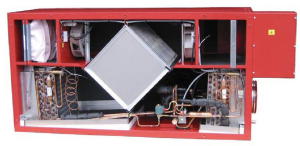Genvex Heat Recovery #3
By Maui Systems Ltd
Why are we doing this?

Fitting Items in the Box
With the fans, sensors, controller and other hardware all working in principle on the bench, it was time to do some test fits and get all the cabling into the actual Genvex.
The new fans need an extra control cable alongside their power feed; previously they were just controlled by varying the mains supply voltage. We are still curious to what is happening inside the unit, expecially when we move on to the heat pump. As we were already having to run new cables, we also ran an exta cable in to create a 1-wire bus, putting temperature sensors in each of the 4 main sections of the device.
As the fans are not the same model, the mounting holes inside the device are no longer in the right locations. Even getting the drill into the confined space is tricky, but with some persistence everything now could be fitted.
We added some self adhesive foam sealant around the fan housings to try to reduce some of the air leaks. Installed the DS18B20 temperature sensors and tidied all the internal cables.
The existing cables were routed back to the external control box area on the right hand side of the unit, as were the newly added cables. This was also the location for the Raspberry Pi and it’s relay board hat.
Control Software
We want the system to run pretty much automatically - but also to be able to see what it’s doing. We’ve used Mosquitto for a number of projects previously, and it seemed to be ideal for this one also - using it as the message passing component allows us to build seperate components to control things, all of which can talk to each other and that communication can be monitored.
Our home automation system supplies the temperature and humidity values from key locations around the house via MQTT messages. The control software was written in C, listening for the messages about humidity and then adjusting fan speeds accordingly - based on a simple flat file with thresholds. If the humidity in the bathroom rises, the fan speeds are increased to help remove the moisture - there are no manual extractor fans in this house. When the humidty drops, the fans slow down and then switch off.
The sensors from the Genvex unit itself (fan speeds, temperatures) are published via MQTT, so we can observe how things are running, without having to open the doors.
So we wrote a monitoring program that brings up a simple representation of the Genvex and shows the sensor details in real time. This also allows the fan speeds to be manually adjusted - by sending control messages via MQTT back to the main controller.
What’s left to do
The intention is to pass the Genvex sensor data back to our home automation system so it can all be viewed in a consistent place; be it mobile devices or dashboard screens. It’s not essential, so it’ll be an autum/winter job.
The extraction side of the controller and Genvex has been working for a number of months; other than tweaking the humidity trigger points and fan speeds, it’s been pretty much a full automated system.
A couple of large bits of customer work and the arrival of an unusually warm summer halted the progress on the heat pump side of the project. So far, we are just moving moist air out of the house; the inlet fans are still manually controlled and have only really been used during the hot days in the middle of summer.
Now the weather is starting to turn, the next steps will be to document and then test the heat pump in the lower part of the Genvex. It was tested years ago when we first had the Genvex inspected, but not really anything else since.